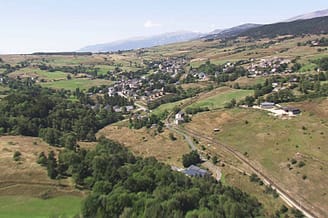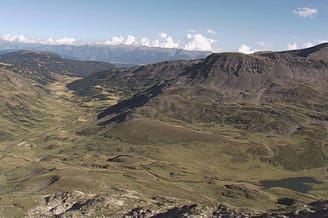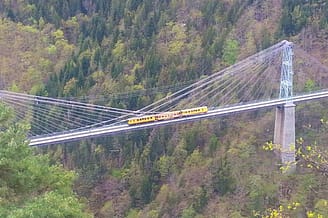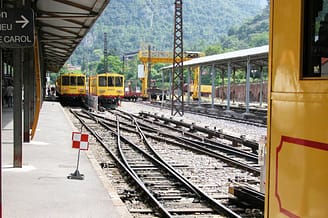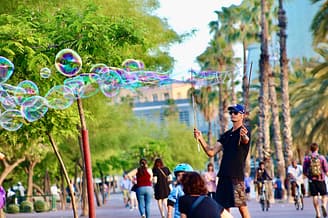Discovering
the Catalan Country

Using Le Brasilia as a base for touring along the coast
in Vermeille
Canet en Roussillon,
the sun-drenched resort!

Canet en Roussillon is the second largest town of the Pyrénées-Orientales after Perpignan. Only 12 kilometres separate Canet en Roussillon from the capital of the Pyrénées-Orientales. This asserted character town wonderfully combines tradition and modernity.
A town with a rich history, as the remains of its Château Vicomtal castle testify, Canet en Roussillon is nowadays fully oriented towards tourism and the future. The 9 kilometres of beach each year attract numerous lovers of idleness, who can moreover indulge in a multitude of sports and leisure activities.
Besides, by the seafront, or in the vicinity of the marina, shops, bars, restaurants, a casino and discothèques make Canet one of the most lively seaside resorts of the Roussillon coast. On the grand Place Méditerranée, concerts and shows also contribute to the summer dynamism of this town!
ONIRIA, the new Aquarium ONIRIA aquarium in Canet: ONIRIA is a new generation aquarium, which offers an immersive journey, to the heart of the world of water, to understand all the secrets of its metamorphoses.
By following a recreational interactive course, the visitor glides under the skin of a drop of water, which will take 1000 years to do its world tour. It is by contemplating the route of this molecule in all its physical states (water, ice, water vapour…), that Oniria enables the exploration of numerous planetary ecosystems.
Also note that just a stone’s throw away from the town centre, theEtang Canet Saint Nazaire lake, a protected lagoon of 600 hectares, is home to exceptional biodiversity. Although numerous pink flamingoes meet there, no less than 230 other bird species have been recorded…
Collioure,
the birthplace of Fauvism
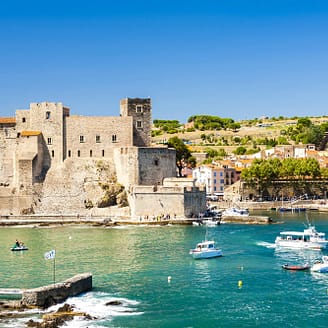
Located less than thirty kilometres from the Le Brasilia campsite, the ancient town of Collioure is one of the most symbolic tourist attractions of the Pyrénées-Orientales. Indeed each year, several thousand tourists and holidaymakers stroll in the paved alleyways of this character town located by the water on the superb Côte Vermeille (Argelès sur Mer to French/Spanish border),.
Collioure is home to a historic heritage of leading importance. Its royal castle for example served, over numerous centuries, as a summer residence for the kings and queens of Majorca! A further curiosity is theNotre-Dame-des-Anges church, whose belfry marks the entrance to the port of Collioure.
For a long time, the charm and beauty of this Catalan town attracted artists.
Amongst the most famous, we could mention Henri Matisse, Pablo Picasso, Salvador Dali, Paul Signac, etc. Nowadays the soul of artists with incredible talent still floats around the old town of Collioure…
Beautiful and wild
the Côte Vermeille…

The Côte Vermeille, the name given to the coast which stretches to the south of the Argelès sur Mer seaside resort, 20 kilometres from Canet en Roussillon, up to the Spanish border, is a genuine gem of the country.
Stemming from the meeting point between the Mediterranean and the mountains of the Pyrenees, the Côte Vermeille is scattered with pedestrian pathways that cross it throughout and enable access tonumerous inlets, each more beautiful than the others…
Equally renowned for the beauty of its sea beds and for the extraordinary biodiversity living there, the Côte Vermeille can also be discovered during a scuba diving session…
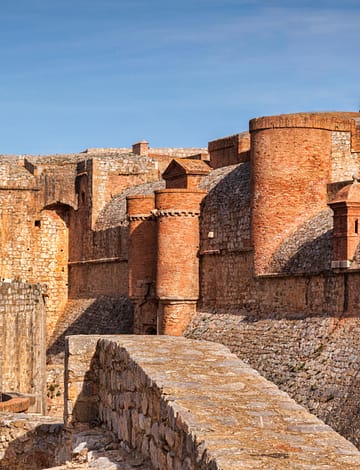
Visits and cultural walks
Perpignan
la Catalane

Although located barely 12 kilometres from the Le Brasilia campsite, Perpignan is a city which leaves nobody unmoved. The prefecture of the Pyrénées-Orientales department, the former continental capital of the Kingdom of Majorca, Perpignan is nowadays a major centre of Catalan culture in Languedoc Roussillon.
You can visit its historic heritage, including the superbPalace of the King’s of Majorca, a fortress palace dating back to the 13th century, but also enjoying a certain way of life and scenery that exists nowhere else on earth. Amongst the must-see locations of the city centre, we can mention the Castillet gateway tower, the Saint Jean cathedral and even the Loge de Mer (built in Renaissance style in 1540).
Perpignan is also a dynamic welcoming town for numerous artistic and cultural events. The “Visa pour l’Image” Festival (festival for international photo-journalism), organised at the end of the month of August and mid-September, being, without doubt, the most renowned of them.
Salses
the fortifications

The Salses fortress is a “neighbour” of the Le Brasilia campsite, as it is only a distance of around twenty kilometres away. A Mecca for the history of the region, this gem of military architecture from the end of the 15th and the beginning of the 16th century, whose forms remind you both of a fortified castle and a modern stronghold. It owes its construction to the wishes of the devout Catholic Royal couple, Ferdinand II of Aragon and Isabella of Castile, to fortify the border of their kingdom against France.
This historic monument, built between 1497 and 1502, is nowadays one of the best conserved defensive systems in the department, and the one welcoming the most visitors each year.
Saint Martin du
Canigou, an abbey
in the mountains

It is an hour’s drive from the Le Brasilia campsite and the seaside resort of Canet en Roussillon that the magnificent Saint Martin du Canigou abbey is located. Built at the summit of a rocky outcrop between the 16th and 17th centuries, entirely surrounded by the mountains, this Benedictine abbey has for nearly a millennium formed part of a sumptuous landscape dominated by the Massif du Canigou mountain (Mount Canigou).
To go there, you have to leave the village of Casteil, located at the foot of the abbey. There, a marked path crosses the scrub land, and enables access to the abbey after, for all that, nearly 40 minutes walk. However, it is worth the candle, and visitors who are pressed for time can admire a genuine gem of Roman art here. A haven of peace, tranquillity and serenity, the Saint Martin du Canigou abbey will surprise you by the beauty of its abbey-church, its vaulted crypt, Lombard bell tower, etc.
Saint Michel de Cuxa abbey,
full of serenity

Also built at the foot of the Massif du Canigou mountain range, in the village of Codalet, in the vicinity of Prades, around 60 kilometres from Le Brasilia, the Saint Michel de Cuxa abbey is a Benedictine monastery dominated by an impressive 11th century bell tower. Access to it proves much easier than that of the Saint Martin du Canigou abbey, as you can park in the immediate vicinity.
Upon arriving in the abbey, do not hesitate to watch the short 20 minute film on offer to you. This enables you to thoroughly understand the history of the attraction, to grasp the smallest details. Then have a free visit to the abbey. You will be struck by the beauty of the building and its peaceful surroundings. In short, besides an edifice which is a remarkable imprint of history, it is an experience of serenity, which you will take part in.

Vestiges of a rich past
the south has its History!
Aude,
the land of the Albigensians

A stay on the Le Brasilia campsite may be the opportunity to go off to explore the Aude and the Pays Cathare (Cathar Country), a tourist area which includes all of this department and part of the Pyrénées-Orientales. The origin of the name given to this region, lies in Catharism, a religious sect having prospered in the south of France in the Middle Ages.
The castles and villages that the Cathars occupied have nowadays become significant tourist sites. Whether to the first group built perched above the peaks of the Massif des Corbières or to the second group which were constructed in the Mediterranean scrub land, each year they attract numerous curious tourists.
Amongst the most emblematic castles of Cathar Country, Montségur, Quéribus, Aguilar or even Puilaurens and Peyrepertuse, simply await you!
Carcassonne,
a town famous for its art and history (ville d’art et d’histoire)

Nowadays a prefecture of the Aude department, the town of Carcassonne owes its international fame to being home to one of the most symbolic medieval citadels in France. The latter, as well as the double ring of ramparts surrounding its feudal castle, is classified on the UNESCO World Heritage list.
Entirely restored by the architect Violet le Duc during the 19th century, the medieval citadel of Carcassonne was easily captured. You can also discover the Musée de l’Inquisition Cathare (Cathar Inquisition museum) here..

Mountain hikes and discoveries
PYRENEES,
AMONGST NATURE
AND TRADITION
The Canigou,
the sacred mountain
of the Catalans
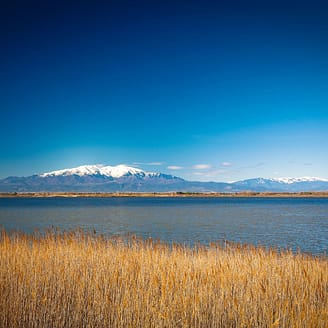
The sacred mountain of the Catalans, the Pic du Canigou mountain is one of the highest summits of the Pyrenees chain. With 2,785 metres altitude, the Canigou dominates the entire Pyrénées Orientales, and offers a spectacular view over the Roussillon plains! On a clear day, those facing south even have the chance of glimpsing the large city of Barcelona, which is however located 200 kilometres away, as the crow flies!
With the designation “Grands Site de France, the Pic du Canigou mountain is also a symbol of Catalan identity. Several paths enable you to reach reach its summit, where a wrought iron cross rises. During the high season, these are taken by numerous hikers.
Although some are set aside for the most experienced, others are accessible to people who are inexperienced.
To help you ascend the Canigou, donkeys can carry your equipment or even a child. Plenty to fully make the most of the landscapes on offer to you. Guides qualified in high-mountain activities for those with disabilities can also go with you. All-terrain wheelchairs pulled by donkeys enable the ascent for those with reduced mobility. An exceptional site adapted for everyone, and which will not leave you unmoved!
Céret,
an authentic character

A sub-prefecture of the Pyrénées Orientales, the charming town of Céret is located around 40 kilometres from the Le Brasilia campsite. In the heart of Vallespir, the historic region of Roussillon crossed by the Tech, Céret is the Mecca for tourism in the Pyrénées-Orientales.
The capital of Cherries, Céret, dubbed “l’authentique” (or genuine), has borne witness to numerous artists strolling through it, during its history. From painter Pablo Picasso to the poet Max Jacob, and the composer Déodat de Séverac and to the sculptor Manolo Hugué. They have all been seduced by the charm of this town whose historic centre nowadays has a Museum of modern Art (Musée d’Art Moderne).
Amongst the curiosities of Céret, its arenas where each year ferias take place in mid-July, but also and especially the Pont du Diable bridge, a structure which is unique for its dimensions (a unique arch with a 45 metre span and 22 metres high) which has risen above the Tech river since the 14th century.
The Conflent
or the valley of treasures

The longest valley of the Pyrénées Orientales, the Conflent valley houses within it numerous listed sites. Amongst these are the superb Orgues d’Ille sur Têt. Located in the village of Ille sur Têt, 38 kilometres from the Le Brasilia campsite, these so-called “fairy chimneys”, as geologists customarily call them, result from the erosion of sedimentary rocks.
Some 55 kilometres from Le Brasilia, Eus is one of the most beautiful villages in France. Built on a terrace on a hill, at the summit of which a church rests on the foundations of a former citadel, Eus is also one of the most sun-drenched villages in France. Every year, its cobblestone alleyways see several thousand visitors stream over them.
The Mont Louis citadel is also one of the most significant listed sites in the Conflent valley. This is an hour and a half by road from Canet en Roussillon. A member of the Réseau des Sites Majeurs de Vauban (Network of Major Sites in Vauban), this citadel is as such registered on the UNESCO World Heritage Site list, like the ten other similar fortifications built by the most famous military engineer for the Sun King (Louis XIV). Intended to protect the French/Spanish border, the Mont Louis citadel is built at 1,600 metres in altitude, which makes it the highest in the country!
The Catalan
Pyrenees

The Catalan Pyrenees, or the Catalan Pyrenees National Regional Park, extends over nearly 66 towns or villages and 1,371 km² of the Pyrénées Orientales department. The leading natural park in the Pyrenees massif, it brings together together the massifs and valleys of Cerdagne, the Conflent, the Capcir ravine , the Pic Carlit, Puigmal and the Canigou.
A hikers’ paradise, the Catalan Pyrenees are a rich area in seven nature reserves and three Natura 2000 sites.. Crossed by the Petit Train Jaune (tourist train) in Cerdagne, this Natural Regional Park also brings together numerous tourist sites, starting with its character villages, its Vauban citadels classified by UNESCO and its numerous ski resorts!
Moreover in the vicinity of one of them, Font Romeu, the famous Odeillo solar furnace can be found. Its dimensions; 54 metres high and 48 metres wide, make it one of the two largest solar furnaces in the world. Just a stone’s throw from here, Héliodyssée enables the general public to be informed in a recreational way on solar energy and the operation of the Odeillo solar furnace.
On the trail
of Vauban in Cerdagne

It is around sixty kilometres to the west of the Le Brasilia campsite and the seaside resort of Canet en Roussillon that the small village of Villefranche de Conflent is located. A member of the association Plus Beaux Villages de France (this translates as “The Finest Villages in France“, Villefranche de Conflent is above all afortress town being a member of the Réseau des Sites Majeurs de Vauban. As such it is classified as a UNESCO World Heritage Site.. Amongst the 50 most visited sites in France, Villefranche de Conflent bears witness to an exceptionally rich heritage. Not far from here, pursue your tourist discovery with the Cova Bastera cave, bearing witness to one of the most striking pasts.
Overlooking Villefranche de Conflent, the Fort Liberia fortress is a gem of military architecture of the 17th century. An underground stairway of 734 steps enables you to access it from the village…
Le Petit Train Jaune,
a must-see
in Cerdagne

Villefranche de Conflent is also known for being the departure point for the Petit Train Jaune (tourist train), one of the most famous tourist attractions in the Pyrénées Orientales. This links Villefranche to Latour de Carol at the end of a winding route that could not be more spectacular of 63 kilometres. In total, 22 stations are served by the Petit Train Jaune, including Bolquère, the highest station in France, built at 1,593 metres altitude…
The Petit Train Jaune (tourist train) is the ideal activity for families The 63 kilometre route enables you to admire the diversity and magnificence of the landscapes without spending hours on hiking routes. Indeed, although the Catalan Pyrenees are ground favourable to hiking, this can quickly become a complicated activity with young children. The entire route is 3 hours’ walk. A pretty getaway, which will appeal to budding photographers, wishing to take some shots of the Têt valley.
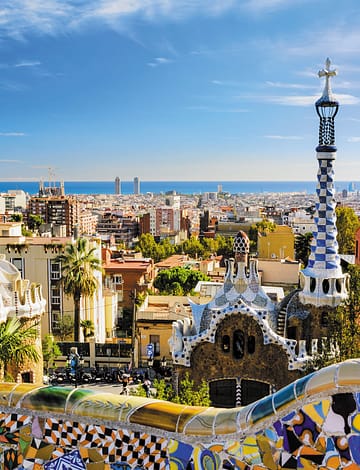
From the Côte Vermeille to the Costa Brava
Barcelona
Barcelona,
the capital of Catalonia
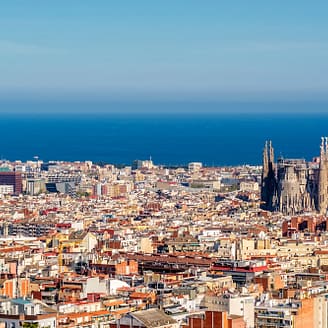
The capital of Catalonia and the second largest city in Spain behind Madrid, Barcelona is 200 kilometres from the Le Brasilia campsite. The leading tourist destination of the Iberian Peninsula, Barcelona enjoys a leading cultural, historic and architectural heritage.
The emblem of the town and the main tourist attraction, La Sagrada Familia unfinished basilica is the most spectacular work by the celebrated Catalan architect, Antoni Gaudi. The construction of this basilica, started in 1882, has not yet been completed and is set to continue through to 2026! It is however possible to visit the building site and the view over Barcelona from the heights of the La Sagrada Familia proves spectacular.
This basilica is not the only work by Antoni Gaudi in Barcelona, the Catalan architect having made his mark on urban planning here. Amongst his other major achievements is the Parc Güell, a magnificent garden within which nestle numerous buildings, sculptures and various ceramics by Gaudi. A must-see for tourists coming to Barcelona, La Rambla is a symbolic avenue which links the Plaça de Catalunya to the old port, dominated by the statue of the navigator, Christopher Columbus.
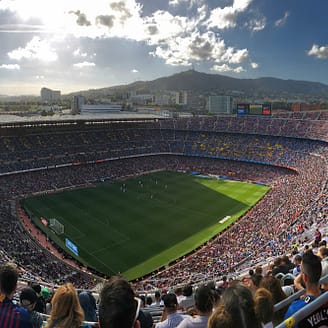
Camp Nou, the famous stadium of the local team, FC Barcelona, is also one of the most emblematic buildings of the city. The museum which it houses displays the various club trophies, and is nowadays one of the most visited in Spain…










































